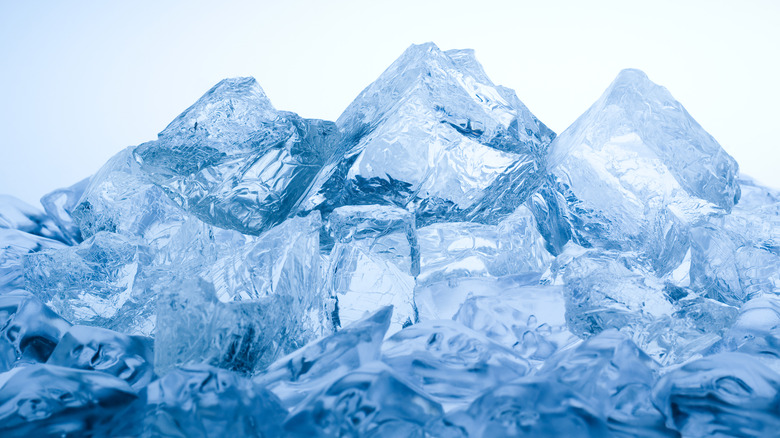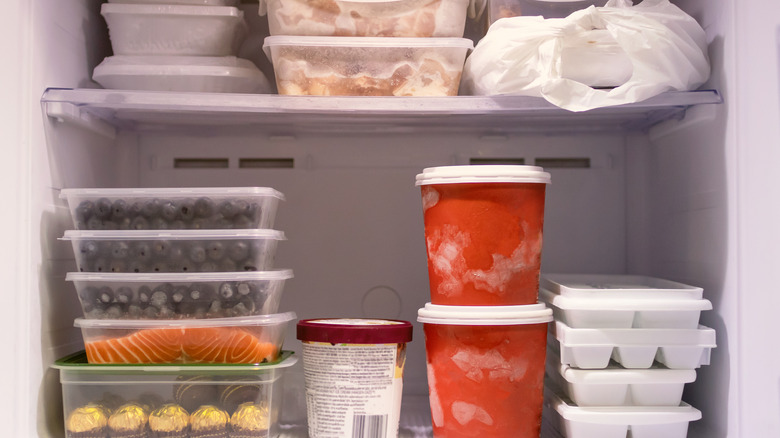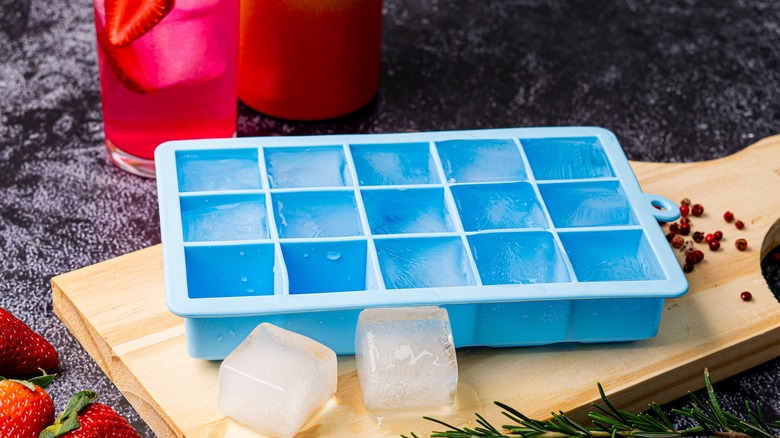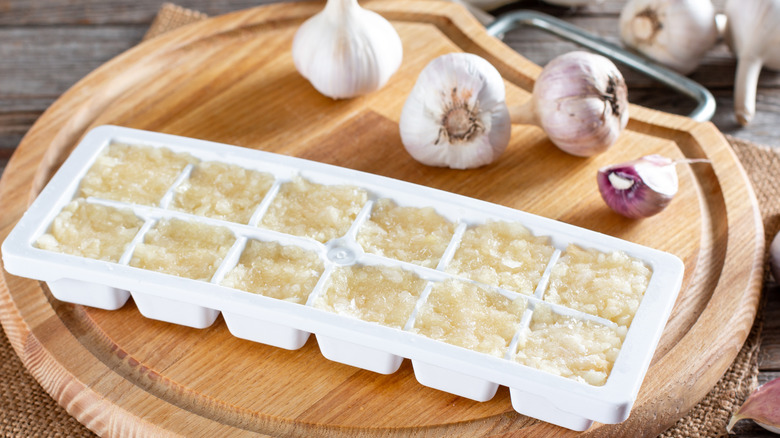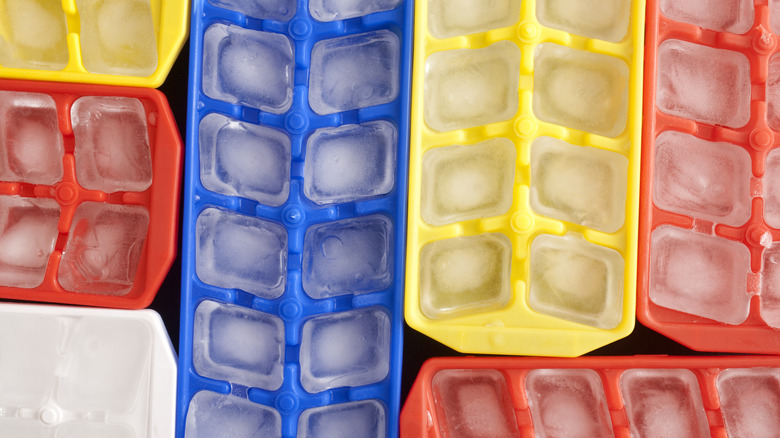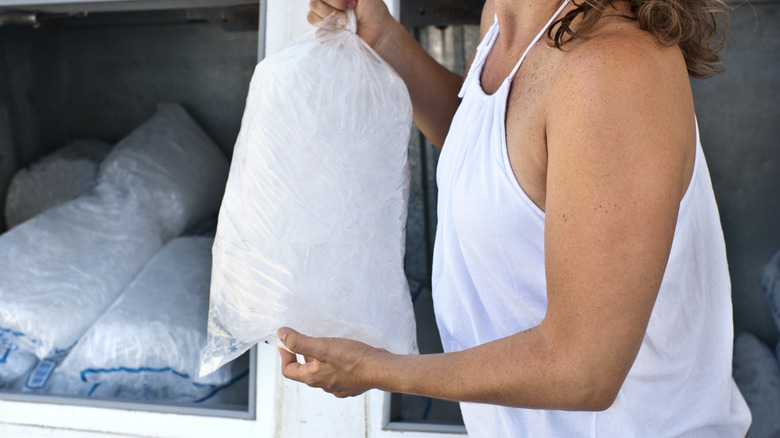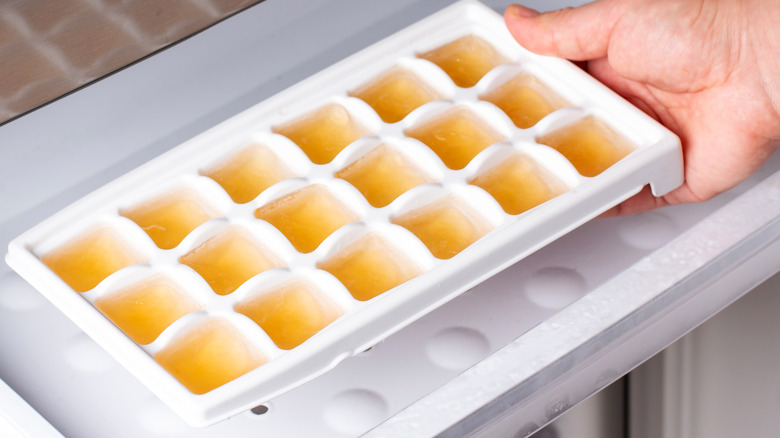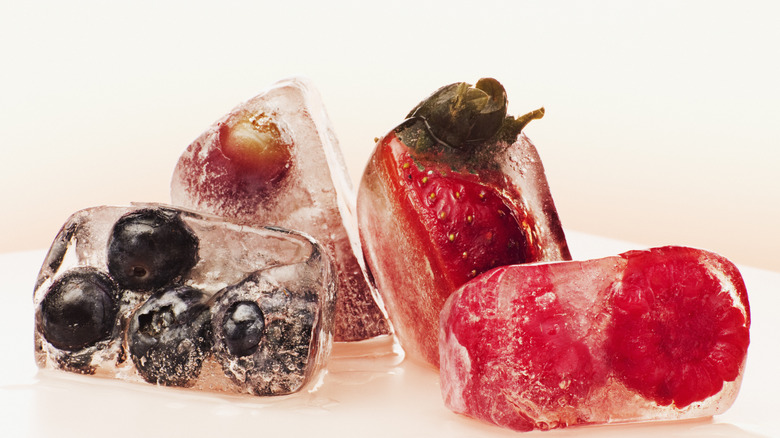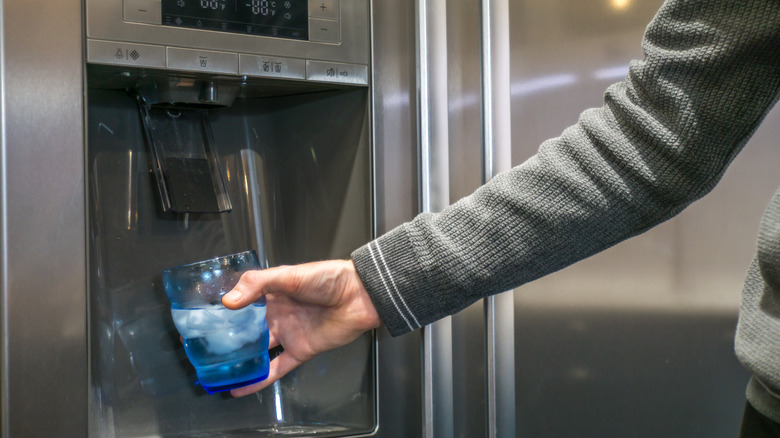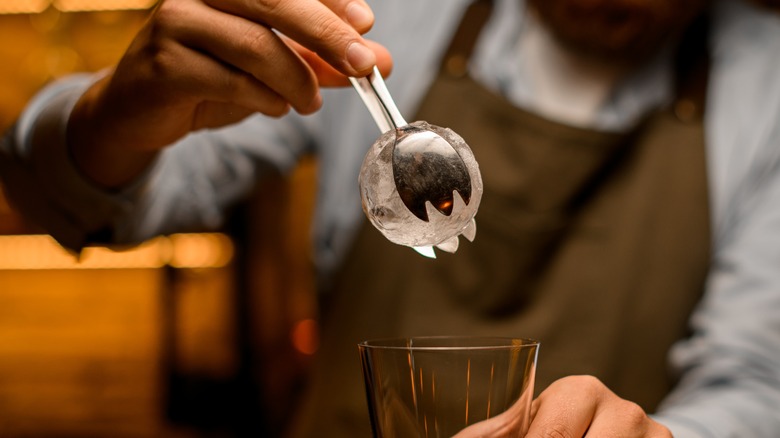The 10 Biggest Mistakes You're Making With Ice Cubes, According To Camper English - Exclusive
Crystalline or cloudy? The character of your beverage's ice can be a hot-button issue for some. Ice cube reporter Camper English preeminently taught the masses how to make perfectly clear ice cubes at home. He's written a book about it — aptly named "The Ice Book" — in case your cocktail focus requires it, or it comes up on "Jeopardy." ("What is: directional freezing?")
You don't get famous for ice unless you're truly passionate. "My freezer is still completely dedicated to ice ... and I generally don't keep any food there," English told us recently. "The way I think of ice is like arts and crafts that you can eat at the end, or drink. So I'm always trying to come up with new shapes of ice or more efficient ways to prepare it." Camper even thinks of ice when window shopping. "I walked through toy stores just looking for [objects] to freeze inside of ice cubes. That's my vision of the world now is, 'will that fit into an ice cube?'" he admitted.
The ice expert didn't detail directional freezing with Tasting Table, but please, consider his book if you're concerned with cube clarity. Camper did, however, walk us through common mistakes you might be making with your ice cubes at home — with one caveat. "I am totally not a fan of the 'you're doing it wrong story,'" English clarified. Please, think of these ice cube tips as more suggestions than ultimatums.
1. Letting ice absorb smells
Do the ice cubes in your ice cube tray smell suspiciously food-perfumed? You've probably got a food storage problem. Even if all your freezer-stored foods are safely sealed and thereby protect your ice cubes from unsavory smells, Camper English warned us that smells will migrate from chilling in your fridge upwards to your frozen goods section. Because air circulates freely through many freezer-fridge combination units, the odors from slightly open food containers (for example, "loose fitting takeout boxes or last night's pizza") can infiltrate your ice cubes even if they're not in the freezer.
Unless you're a fan of ice water that, per English, "tastes like garlic shrimp" or last night's pepperoni pie, the ice expert suggests opting for one or two courses of action. Either seal all your foodstuffs tightly — regardless of where to put it in your at-home cooling unit — or store your ice cubes safely in Ziploc bags or plastic containers with lids.
2. Storing ice in their silicone ice trays
All your chilled foods are safely sealed, but you still have pungent cubes. In that case, your ice cube mold of choice may be the culprit. Those faithful to stainless steel or hard plastics ice trays need not remove cubes once fully formed. Maybe, however, you've opted for silicone ice cube trays in hopes that you'll never have to clean up sorry shards of ice from your kitchen counter after a brutal ice-extraction brawl. In that case, be warned.
If rubbery, food-grade silicone ice cube trays are ultra-flexible and easy to manipulate, they're also odor-absorbent. As English told us, "Silicone can also pick up smells from the freezer and refrigerator." To avoid having the smells from your silicone tray transfer to your cubes, remove them immediately after they've frozen into shape. That would be — anecdotally — anywhere from two to four hours, depending on the size of your cubes and your freezer's temperature.
3. Not cleaning smelly ice trays
The worst has finally happened: your silicone ice trays absorbed the smells of Tuesday's quesadillas, last week's chicken tenders, or last month's sushi. Or could it be that they're moonlighting as frozen soup stock containers? Don't take your smelly silicone out of commission yet. While freezing ice in already-odorous silicone trays might be a "Beavis and Butthead"-style culinary decision, it is possible to liberate silicone ice molds from unwanted odors. Simply bake them shortly in the oven, suggests Camper English, and the odors will disappear.
If, on the other hand, you notice something that looks suspiciously like what English calls "ice dandruff" building up on your silicone trays, it might be time to say goodbye. Those flake-like bits of ice dandruff are red flags. "I think those come from mineral buildup," English explained. "I've been unable to find a way to get rid of it. I've ended up just replacing those trays after that starts to happen."
4. Letting the ice sublimate
Leave your ice cubes in their trays, whether silicone or otherwise, and they'll sublimate (change from a solid to a gas) faster. In other words, per Camper English, author of "The Ice Book," you're speeding up your cubes' eventual demise.
Your level of sublimation concern will likely depend on what kind of ice cube consumer you are. If you're a frequent, fanatical consumer of frozen water, you've probably never kept your cubes long enough for them to begin sublimating noticeably. As per English, "It would take probably a week to even notice that your ice was getting smaller."
If, on the other hand, ice cubes are an afterthought in your household, you can take preventative measures to prevent sublimation. While all cubes, according to English, "will reduce down to nothing," eventually, storing cubes in closed containers slows down sublimation substantially. That makes storing your ice cubes in Ziploc bags or lidded Tupperware a win-win: you'll prevent funky odors while simultaneously increasing your cubes' freezer life.
5. Letting wet ice stick together, especially in bags
You've dutifully stored your ice cubes in bags to prevent them from shrinking prematurely and acquiring unwanted scents. Perhaps, too, you invested in large bags of ice from the supermarket ahead of an upcoming party. Pat yourself on the back. Don't, however, make the mistake of thinking your ice-care duties are done. Bagged ice comes with its own hazards, particularly if you're prone to taking ice bags in and out of the freezer and using small quantities of cubes at a time. Do that, and you'll create "wet ice" — partially unfrozen cubes that will stick together into a single, unwieldy block of frozen H20 if put back into the freezer and left there.
That's the bad news. Here's the good. There's an easy hack to avoid removing a giant, unintentional ice sculpture from your freezer when entertaining at your annual summer extravaganza. If you've created wet ice, "you can stop it from sticking before it's too late," English assured us. Put it into your freezer, says the ice expert, "but after 10 minutes, break it up ... it should not stick together after that."
6. Not making enough ice for special events
If the idea of wet ice cubes freezing together in big bags has you panicking like "Friends" Monica Geller, there's no need to rely on them for a party. Buying ice bags is one way to avoid running out of ice in the middle of — your mom's 90th birthday bash, for example — but you can also create enough cubes with the ice trays you have at home. You don't need to invest in dozens of trays to ensure sufficient supplies on party day, either.
Instead, start hoarding your party ice supplies well in advance. "Unless you choose to buy your ice at a store, just start a week early and ... empty your trays every night into [individual] Ziploc bags and stock up," Camper English recommended to Tasting Table. Err on the side of caution and make more frozen water than your party's guest list demands. If, English says, you manage to fill your whole freezer, "you probably won't run out."
7. Freezing sugary liquids and carbonated beverages
Ice cube trays are absolutely wasted on water alone. Get creative with flavored ice cubes, says Camper English, but keep three rules of thumb in mind. First, if you're freezing liquids to add color to cubes, know that flavored ice is usually opaque. "A clear cube and a colored cube don't really happen at the same time," English stipulated. If clarity is your prime objective, stick to H20.
Second, flavored ice is not compatible with your large ice cube dreams. As per English, flavored frozen liquids "tend to be softer and squishy, and those work better in smaller cubes." Third, certain liquids should never make your ice cube tray acquaintance. As the ice cube expert told us, neither sugary liquids, alcohol, nor carbonated beverages freeze well. You're right. That does make Coca-Cola cubes a nonstarter unless, says English, you're willing to make a mess.
We've given you a list of frozen liquid "can't dos." Here are the "can dos." Per English, two juices are particularly great for freezing in ice cube containers: cranberry and orange.
8. Freezing choking hazards inside cubes
What, exactly, you should freeze inside your ice cube depends on the intended fate. Purely decorative? Then browse your toy stores' aisles for freezable artifacts like Camper English does. Are they edible art? In that case, consider the following factors.
First, per the ice cube expert, when freezing plants inside ice cubes for the perfect spring drink, remember, "Just because a plant is organic and natural doesn't mean it's safe." All plants destined for your ice cubes should also be edible, which rules out many of the flowers you might purchase from the florist. "I always say a poison ivy is, is organic too," English quipped. "You want edible flowers, not display flowers." Second, avoid objects that might become choking hazards once rock solid, especially if the cubes are meant for alcoholic drinks. "Don't give ice cubes with objects in them to drunk people because they might take it as a challenge to see if they can swallow it," English recommended.
Last but not least, keep in mind that many objects only become visible in ice once you've mastered the art of clear ice-making. Citrus peels are great things to start with, according to the ice cube expert. "If you're a beginner, citrus peels are a great thing to freeze. You can peel them and make a twist or cut them into a shape or a letter or something like that, and they'll freeze nicely in a clear cube or whatnot," English affirmed.
9. Relying on your ice machine for everything
First, the positive: in-built ice machines offer one very distinct advantage when it comes to frozen water: the threat of ice cube sublimation will never keep you up at night. Why would it when you have tech that can churn out fresh ice cubes on a moment's notice?
Camper English, however, has consciously opted out of the technology. "I personally chose to not have one in my freezer because I don't like that type of ice," he explained to Tasting Table. "I prefer to make my own in whatever size that I want." While there's nothing wrong with ice-machine-styled ice cubes for chilling a glass of water, English recommends not relying on one for all your ice cube needs. Stay true to your ice machine, and you'll be stuck with uniformly-sized crescent-shaped cubes for an eternity. Just ask English. It's much more exciting (and fulfilling) to get creative with cubes.
10. Sticking to one style of ice
Don't make the mistake of thinking ice has to be boring. Let yourself go down the ice cube rabbit hole a little (or a lot), says Camper English. "Ice is really easy to make and it doesn't cost you anything unless you go overboard like I've done. And you can have a lot of fun with it," the ice expert affirmed. The easiest baby step into the ice world is creating large ice cubes. Purchase yourself a two-inch silicone ice cube tray, English says, and you're off to the races.
Learning to create different sizes of ice is more than just a creative endeavor, of course. It can also elevate your drink experience significantly. Put simply: the best ice for a cocktail isn't necessarily the best ice for your favorite Fanta. "Use large cubes for something you want to sip slowly and doesn't need a lot of dilution, such as a whiskey on the rocks," English suggests. Small ice cubes, on the other hand, are great for "room temperature," liquids, says English, for example, "soda on a hot day that you wanto get cold, fast."
